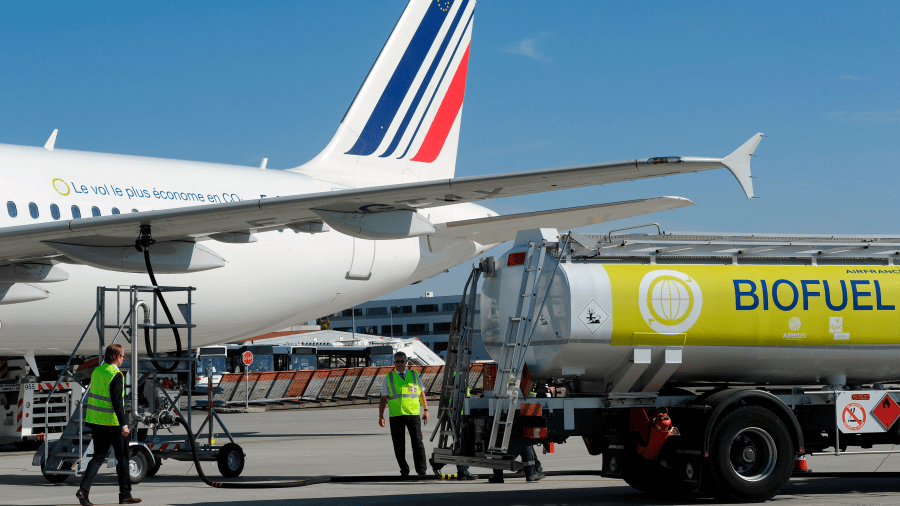Got to fly like an eagle (by which we mean, have an insignificant carbon footprint)

The holidays often mean traveling, which frequently means flying.
For many who are hyper-aware of their carbon footprint, flying can bring on a guilt trip. Commercial flights account for about 2.5% of global CO2 emissions. The Swedes even coined a term for it, “flygskam,” which translates to “flying shame.”
Now, though, there are a variety of sustainable aviation fuels designed to lower the emissions generated by air travel.
We spoke with Evan Sherwin, a postdoctoral researcher in energy and resources engineering at Stanford University, about the kinds of sustainable jet fuels out there. The following is an edited transcript of our conversation.
Evan Sherwin: Sometimes we call them drop-in fuels, because they drop in to the existing infrastructure. There are a few different types of those. The most commonly talked about, at least, are biofuels, which are from various types of plants and refined into chemicals that are very similar to existing jet fuel, are compatible with existing engines. There are also what are called electrofuels, which are produced from combining carbon dioxide that’s been taken out of the atmosphere and combining that carbon dioxide with hydrogen. There is a process to produce synthetic jet fuel that is already approved for blending up to 50% in commercial flights and could, especially for some newer models, go substantially higher than that. This is something that we can do right now. The question, really, is the cost.
Jed Kim: What would be the most effective ways to bring down costs?
Sherwin: In historical experience, one of the most effective ways is through deployment. With solar panels, costs have come down enormously. If you look back to the very early days of solar cells in the, I guess, the 1960s and 1970s, it’s come down by something like a factor of 1,000. And much of that has been just as we deploy more, we get better at making it. We figure out how to make bigger facilities that are more efficient. We’ve seen similar cost declines over the past decade with wind, with batteries, and we’re starting to see that with hydrogen electrolyzers.
Kim: Why are we talking about sustainable aviation fuel? I mean, when we’re talking about cars, we’re talking about electrification. Why aren’t we talking about that for the airline industry?
Sherwin: There certainly are electric options for aviation. For shorter flights, this is likely to be a very attractive option. There are planes announced that have ranges of, ballpark, 500 miles — that’s a lot of regional flights. The difficulty with electrification is that in an airplane, weight really matters. And the amount of energy per unit weight of a lithium ion battery, one of our most common types of batteries, is only about 2% of the energy per unit weight for conventional jet fuel.
Kim: So it’s just too heavy to be viable.
Sherwin: For the longer flights, yes. At least, right now.
Related Links: More insight from Jed Kim
If you want to check out Evan’s analysis of the economic viability of sustainable fuel for flying, we’ve got a link to his paper.
I mentioned that the Swedes seem to be extra anguished about flying emissions. That may be why some companies there are partnering up to develop sustainable aviation fuel on a large scale. The partnership, which includes Shell and Scandinavian Airlines, aims to produce 50,000 tons of electrofuel by converting carbon dioxide. They’ll be getting their power from renewable sources and their carbon dioxide from the byproducts of a heating and power plant. If successful, it’ll provide almost a third of the jet fuel they need in order to reach national targets of fossil fuel-free domestic flights.
Sustainable jet fuel is one thing. Fully electric planes are another. Marketplace’s Kai Ryssdal, who used to fly planes, once spoke with an expert about short haul flights using batteries.
And for more on climate …and lithium batteries in particular…we highly recommend listening to Molly Wood’s new podcast “How We Survive.” Not everyone can make the story of batteries funny and moving…but Molly can!
The future of this podcast starts with you.
Every day, the “Marketplace Tech” team demystifies the digital economy with stories that explore more than just Big Tech. We’re committed to covering topics that matter to you and the world around us, diving deep into how technology intersects with climate change, inequity, and disinformation.
As part of a nonprofit newsroom, we’re counting on listeners like you to keep this public service paywall-free and available to all.
Support “Marketplace Tech” in any amount today and become a partner in our mission.


















